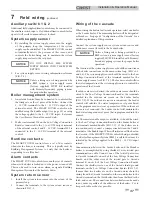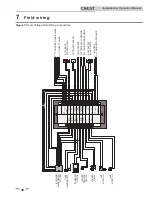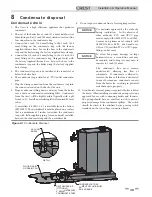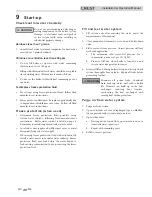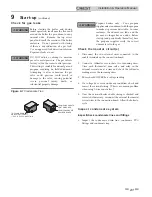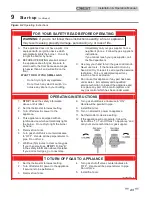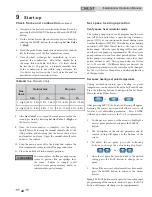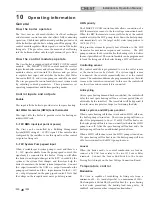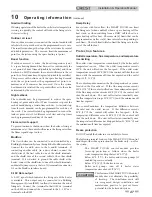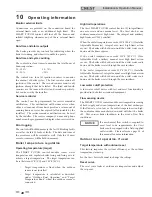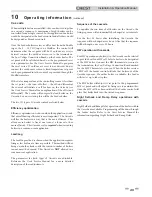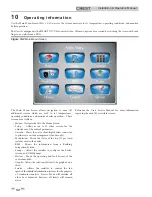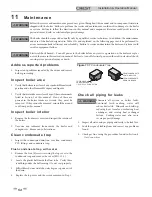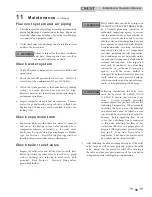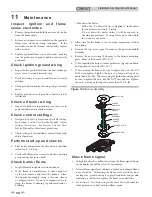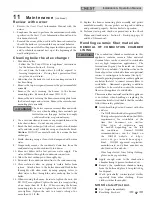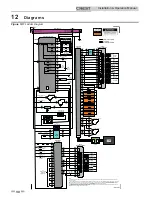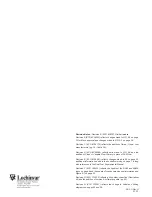
10
Operating information
(continued)
49
Installation & Operation Manual
Cascade
When multiple boilers are installed, they can be wired together
in a cascade sequence. A maximum of eight boilers can be
controlled from a single control. In this application one boiler
would be designated as the Leader control and all others would
be designated as Member controls.
Once the Leader boiler receives a call for heat from the Enable
input, the 0 - 10 VDC input, or ModBus, the control will
determine what the set point will be. If outdoor air reset is
desired, connect the outdoor air sensor to the terminals on
the Low Voltage Connection Board on the Leader boiler. The
set point will be calculated based on the programmed reset
curve parameters. See the Crest Service Manual to program
the reset curve. If outdoor air reset is not desired, do not
connect the outdoor air sensor. A fixed temperature set point
can be programmed into the control, or provided through the
ModBus interface.
If the water temperature at the controlling sensor is less than
the set point + the turn-off offset - the off-on differential,
the control will initiate a call for heat on the Cascade (see
the Crest Service Manual for an explanation of the offset and
differential). The Leader will energize the lead boiler on the
Cascade. For a new startup this will be the Leader boiler.
The two (2) types of Cascade control are listed below:
Efficiency optimization
Efficiency optimization is chosen when the application is such
that overall heating efficiency is most important. The Cascade
will fire the boilers in a way that is the most efficient. This
allows more boilers to fire at one time, at a lower rate, thus
more efficient. This Cascade is also
required
when cascading
boilers in a common vent application.
Lead/Lag
The Lead/Lag method is chosen when the application requires
firing as few boilers at a time as possible. This method will not
bring on another boiler until the current number of boilers
cannot meet the demand. This Cascade is
NOT
allowed in a
common vent application.
The parameters for both types of Cascade are adjustable.
Reference the Crest Service Manual for a more detailed
description of these adjustments.
Sequence of the cascade
To equalize the run time of all boilers on the Cascade, the
firing sequence will automatically be changed at set intervals.
For the first 24 hours after initializing the Cascade, the
sequence will be changed every hour. After that the sequence
will be changed once every 24 hours.
HW operation with cascade
For HW operation any boiler(s) in the Cascade can be selected
to provide heat for a HW call. Select a boiler to be designated
as the HW boiler. Connect the HW thermostat or sensor to
the terminals on the Low Voltage Connection Board marked
for the HW Thermostat or sensor. When the boiler receives
a HW call, the Leader control will take that boiler out of the
Cascade sequence. If another boiler is available, the Leader
will start it up to take its place.
The HW boiler will adjust its set point to the programmed
HW set point and will adjust its firing rate to maintain this.
Once the HW call has been satisfied, the Leader control will
place that boiler back into the Cascade sequence.
Night Setback and Ramp Delay operations with
cascade
Night Setback and Ramp Delay operation of the boilers within
the Cascade are available. Programming will be done through
the Leader boiler. Refer to the Crest Service Manual for
information regarding Night Setback and Ramp Delay.



